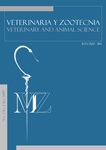Authors
Abstract
ABSTRACT: The aim of this study was to compare the effects of two anesthetic combinations: tiletamine/zolazepam 5 mg/kg IM and ketamine 10 mg/kg + xylazine 0.5 mg/kg IM in 16 free-living adult capybaras (Hydrochaerus hydrochaeris itsmius) captured in the department of Córdoba, Colombia. The subjects went through classic conditioning for their entrance to a cage trap where they were anesthetized with darts using a blowgun. Heart and respiratory rates, rectal temperature, muscle relaxation and side effects were evaluated. All these parameters were checked every 15 minutes during 60 minutes. The results showed that the two anesthetic combinations are safe and do not cause greatest collateral effects when administered intramuscularly in capybaras. Ketamine-xylazine combination produces greater bradycardic effects and inspiratory dyspnea compared to using tiletamine-zolazepam. For chemical restriction on animals with cardiac or respiratory compromise it could be counter-productive to use the ketamine-xylazine combination, if an 2-adrenergic antagonist is not available.. Both combinations are recommended for routine procedures
References
Cruz, M.L.; Luna, S.P.L.; Moura, C.A. et al. Técnicas anestésicas injetáveis em capivaras (Hydrochoerus hidrochoerus, Linné). Ciência Rural, Santa Maria, v.28, n.3, p.411-415, 1998.
De Souza, C.; Berger, S.; Camargo, C. et al. Papel da capivaras Hidrochoerus hidrochoerus na cadeia epidemiológica da febre maculosa brasileira. Revista Brasileira. Parasitologia Veterinária, v.13, p.203-205, 2004 (suppl.1).
Di Rienzo, J.A.; Casanoves, F.; Balzarini, M.G. et al. InfoStat versión 2012. Grupo InfoStat, FCA, Universidad Nacional de Córdoba, Argentina, 2012. Disponible en: http://www.infostat.com.ar
Escobar, A.; González, J.E. Estudio de la competencia alimenticia de los herbívoros mayores del Llano inundable con referencia especial al chigüiro (Hydrochaerys hydrochaeris). Agron Trop, v.26, p.215-227, 1976.
Fowler, M.; Cubas, Z. Biology, medicine and surgery of South American Wild Animals. 1.ed. Iowa State University Press. 2001. 225p.
González, O.; Naranjo, F. Caracterización poblacional, hábitos alimenticios y hábitat natural del chigüiro (Hydrochoerus hidrochoerus isthmius) en el Corregimiento de Villanueva, Municipio de Valencia. Córdoba, Colombia. Universidad de Córdoba, 2007. Tesis (Pregrado).
Herrera, E.A. Comportamiento, conservación y manejo de fauna silvestre: el caso del capibara en Venezuela. Etología, v.7, p.41-46, 1999.
Nishiyama, M.S. Ketamine-xylazine, tiletamine-zolazepam and tiletamine-zolazepam-levomepromazine combinations in capybara (Hydrochoerus hydrochaeris) anesthesia / Associação cetaminaxilazina, tiletamina-zolazepam, e tiletamina-zolazepamlevomepromazina na anestesia de capivara (Hydrochoerus hydrochaeris). Minas Gerais, Brasil: Universidade Federal de Viçosa, 2003. 94p. Tesis (Maestría en ciencias veterinarias).
Muñoz, D.; Montoya, G. Valores hemáticos del ronsoco (Hidrochoerus hidrochoerus) en cautiverio en la Amazonía Peruana. Revista de Investigaciones Veterinarias del Perú, v.12, n.1, 2001.
Ojasti, J. Estudio biológico del chigüiro o capibara. Caracas, Venezuela: Fondo Nacional de Investigaciones Agropecuarias, 1973. 277p.
Pachaly, J.R. Restraint of the paca (Agouti paca) with ketamine hydrochloride, acetylpromazine maleate, and atropine sulfate. Journal of zoo and wildlife medicine, v.29, n.3, p.303-306, 1998.
Resoagli, E.H.; Bode, F.F.; Resoagli, J.M. et al. Linfocentros de la región cervical y cabeza de Hidrochoerus hidrochoerus (Lineo 1766) -Estado de Avance-.Universidad Nacional del Nordeste. Secretaría General de Ciencia y Técnica. Comunicaciones Científicas y Tecnológicas. 2008.
Sánchez, P. Factibilidad ecológica del manejo sostenido de poblaciones silvestre: el caso de un programa de cosecha en vida libre del chigüiro (Hidrochoerus hidrochoerus). In: I Congreso Colombiano de Zoología - año 2000. Bogotá. Memorias… Instituto de Ciencias Naturales, Universidad Nacional de Colombia; 2001. p.154-159.
Short, C.E. Principles & practice of veterinary anesthesia. Baltimore: Williams & Wilkins, 1987. 669p.
Spinosa, H.S.; Gorniak, S.L. Tranquilizantes e relaxantes musculares de ação central. In: Spinosa, H.S.; Górniak, S.L.; Bernardi, M.M. (Ed). Farmacología aplicada a medicina veterinaria. Rio de Janeiro: Guanabara Koogan, 1996. p.131-139.
West, G.; Darryl, J.; Caulkett, N. Zoo animal and wildlife immobilization and anesthesia. 1.ed. Iowa, USA: Blackwell Publishing Profesional, 2007. 655p.

 PDF (Español)
PDF (Español)
 FLIP
FLIP










